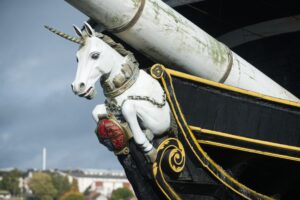Craigowl Primary School museum project
A joint project between Craigowl Primary School, HMS Unicorn, Museums Galleries Scotland, and Developing the Young Workforce.

The project
The aim of this project was to highlight the exciting, varied roles behind the scenes in museums and give the pupils a flavour of the practical skills required for these jobs. We worked with 29 pupils in the P7B class at Craigowl Primary School in Dundee.
We wanted the young people to gain experience in bringing out the interesting stories from HMS Unicorn’s past to bring history to life for our visitors. Therefore, we asked them to create two different activity books for visiting school groups, one aimed at P1-4 on Life in the Georgian Navy, and one aimed at P5-7 on HMS Unicorn – History and Design.
We launched the project on board HMS Unicorn. The pupils came for a visit to the ship where they discussed the design brief for the activity books. The children chose whether they wanted to work on the ‘Life in the Georgian Navy’ activity book or the ‘HMS Unicorn – History and Design’. After this initial session on the ship, the pupils carried out the work back at their school over another six sessions on a weekly basis. Following this the pupils created a presentation based around the work they did for the project. After the presentation we had a prize giving session for the pupils where they each received a certificate and family tickets to HMS Unicorn and RRS Discovery, thanks to support from Museums Galleries Scotland.
The activity books that were created by P7B will be printed, thanks to support from Developing the Young Workforce and available for school groups to use on board HMS Unicorn for self-guided tours. We also created a display on the ship showing some of the original design work for the activity books and photographs of the pupils taking part in the project.
Challenges and successes
- The biggest success was the passion and enthusiasm that the pupils put into their activity books. Due to the nature of the project, the children could focus on an aspect of the activity book that suited their strengths and interests. As a result of their enthusiasm, they had creative ideas and felt confident in expressing them.
- As the project was multi-faceted the children gained a greater number of transferrable employment skills that will be useful for their future careers, including careers in heritage. Many of the pupils thought that they had improved their transferable skills.
- The presentations were a great way of rounding off the project and making it more of an occasion. We’ve created a display on board HMS Unicorn so that when the pupils visit again with their families, they can see photographs of the children working on the project and some of the original artwork and material they produced for the activity books.
- One of the challenges that we faced was that the overall project took more time than we anticipated. This was partly because it was difficult to find relevant research information for the pupils to understand and use for their activity books independently with their teacher. We ended up having three in classroom sessions with HMS Unicorn staff, where we provided child friendly resources as part of this. This resulted in a much better learning experience for the pupils.
The impact it has made
- The main impact for HMS Unicorn is that not only do we have two new activity books that we can use to enhance visits from future groups, but we have also gained a valuable insight into what aspects of our ship’s history and related activities children of that age find interesting.
- Pupils learned useful transferable skills for future careers, but also gained an insight on what jobs are actually available within museums and a taste of these jobs. This will hopefully have a positive effect on the diversity of the heritage workforce in the future.
- While only approx 15% of the pupils had visited HMS Unicorn before the project, 96% said that they would return to visit us again. Combined with the family tickets that each child received as part of the project, there has been a positive impact on the children’s perception of HMS Unicorn, helping to reduce some of the barriers for them in visiting the museum.
- Through this project HMS Unicorn has also built a relationship with a local school in Dundee, in one of our target areas, that we’ve never worked with before. We will keep up this connection through other events and projects in the future.
Lessons learned
- While the range of different tasks that were involved in creating the activity books was useful in keeping the class engaged, smaller teams would have worked better, rather than just three teams of Research, Design and Promotion. This did evolve over the course of the project as the children focussed on their individual tasks.
Guidance
- Having different roles within each team worked well and the project was flexible enough that we could base the tasks around the skills of the pupils themselves, which helped to maintain their enthusiasm and participation in the project.
- We created a design brief for the pupils, which gave the pupils an idea of what we expected and an experience of working to a brief. We also tied this into examples of good and bad designs so that they were able to avoid some common design mistakes from the start.
- Two separate evaluation sessions at the beginning and end of the project helped us to measure the children’s knowledge.
Further information
If you would like more information about this project please contact Markus Offer, Skills Development Manager, Museums Galleries Scotland, email: MarkusO@museumsgalleriesscotland.org.uk